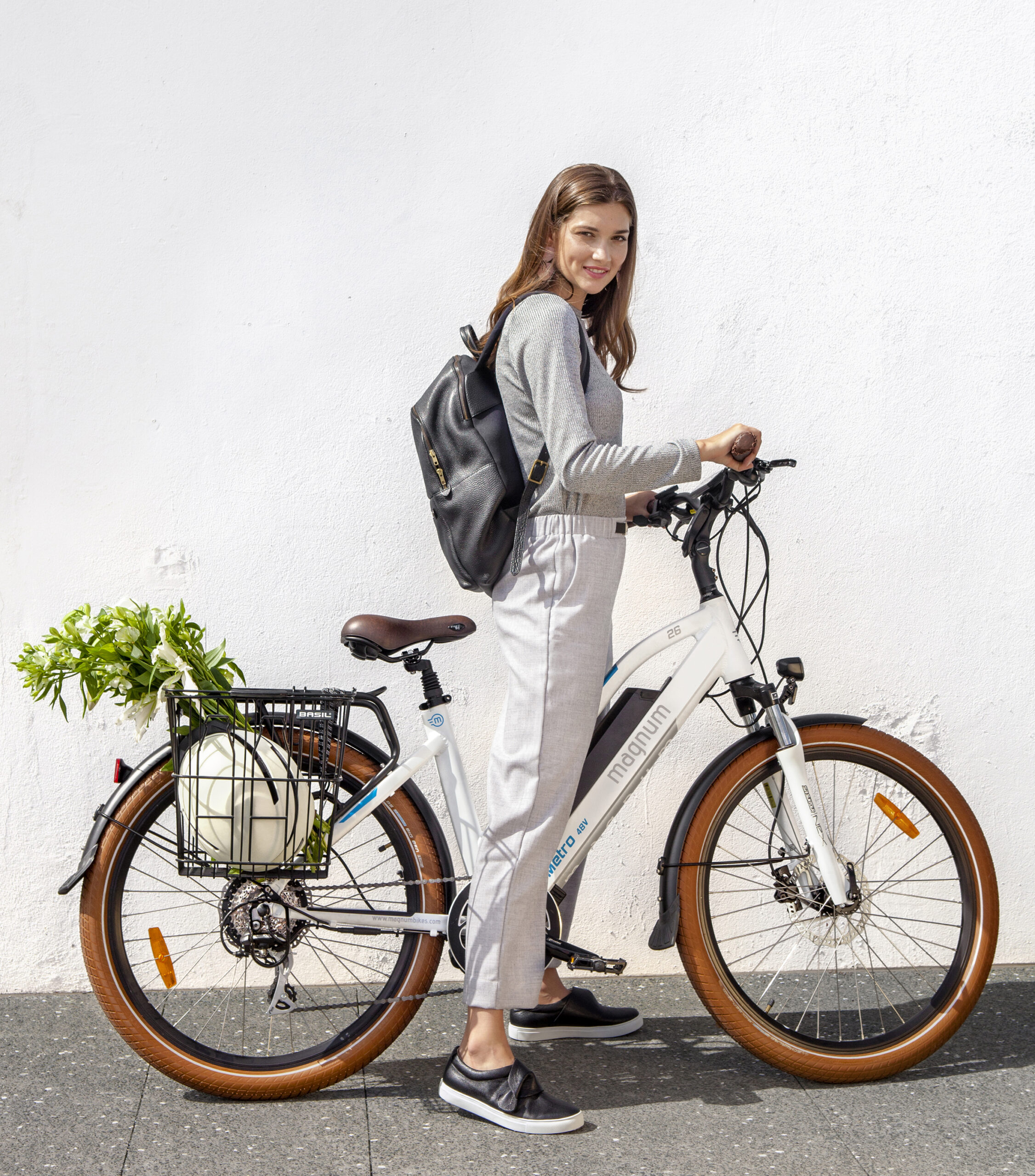Words Natalie Cyra. Photography Sara Orme
From issue 59.
What makes an e-bike so great? We answer some commonly asked questions about the latest eco-friendly revolution hitting the streets in New Zealand and around the world.
It sometimes feels we are living at such a fast pace that the need to get things done in record time is at an all-time high. Pair this with more traffic on the roads and an increased awareness of climate change and conscious living, and it’s no wonder e-bikes have become a real revolution in recent years.
Imagine getting to work in half the time it normally takes (goodbye peak hour congestion), or running errands sans car – and minus hefty petrol bills, too. This is what tens of thousands of Kiwis and millions of others around the world are now opting for – simply getting things done on two wheels.
The latest Electric Bike Worldwide Report states there are 200 million e-bikes around the world, and predicts this will grow to 2 billion by 2050. Currently, around 40,000 of these are in New Zealand, up to half of which were imported in the year to October 2017, indicating real customer demand for a more convenient, environmentally friendlier way of getting around.
“E-bikes are growing really fast in popularity right now, and it’s because the price, quality and look of e-bikes has dramatically improved in the last few years,” says Michael Tritt, founder and CEO of e-bike importer and retailer Electrify NZ. “We are seeing people seriously looking at e-bikes as transportation options – they’re sick of sitting in traffic, they want to do something a bit healthier, a bit greener, so they’re getting on an e-bike.
“People who haven’t been on a bike in perhaps a long time, are now back on, because e-bikes enable them to take on terrain they might not have been able to do previously,” Tritt adds.
Going electric has never been so affordable, trendy or maintainable. But where to start when looking for your new ride?
What’s the main difference between a regular bicycle and an e-bike?
Put simply, an e-bike is complete with a battery-powered motor, which assists with pedalling (so you won’t turn up to work a sweaty mess) and more challenging terrain (you can go off-road and ride with ease up those nasty hills which previously deterred you from riding in the first place). You still have to do some work, says Tritt, “but the motor on the bike supplements your effort, so you sort of become a superman or a superwoman. You can go faster, further, and you can take on terrain without necessarily breaking out into a huge sweat.”
How does the battery work?
The battery usually sits in the middle of the bike and provides the energy to power the wheel to help pedal you along. “The cool thing about e-bikes is that you can choose how dependent you are on the motor,” says Tritt. If you want to go it alone, you can, or if you need a little help, you can have it.
The duration of an e-bike battery depends on a few things, like the size of the battery and how much the rider relies on the bike to power them along. A typical e-bike battery might carry you 50-70km, using assisted riding. And the best thing is, when the battery needs charging, simply take it off the bike (they’re usually removed with a key) and plug it into a power socket for four to six hours.
How fast do e-bikes go?
Speed varies with each brand and model, as well as the rider. Some European brands will often come limited to 25km an hour, while some American brands can get up to between 40-50km an hour.
“There’s generally a bike for everyone, and the other factor is you – if you pedal hard on a bike you can go faster. If you just want to pedal casually, you can cruise along at about 20-25km an hour no problem,” says Tritt.
E-bikes usually have a screen which shows you speed, remaining battery and power level. “More sophisticated bikes can even be paired with apps, which can do anything from analysing your ride data to providing anti-theft features and GPS tracking,” adds Tritt.
How much are they and what’s the maintenance like?
E-bikes start at about $2000 and go up to more than $8000. E-bikes don’t need any more maintenance than a regular bike and the electronic components generally don’t need servicing.
Are they road legal?
In New Zealand, e-bikes fall under the banner of a “low-powered vehicle”, according to the New Zealand Transport Agency. Legally, the motor must be 300W or less for them to be considered bicycles. That means they aren’t classed as cars, and can be ridden without a licence, unlike a motorcycle. E-bikes should be ridden in the same capacity as bicycles, using bike lanes or along the side of the road, rather than in the middle.
5 things to consider when buying an e-bike
Brand
Do your research and choose an e-bike from a reputable brand – after all, it’s an investment for the future. To avoid cheap knock-offs, head to a registered e-bike retailer for some expert advice rather than searching online.
Test driving
Would you buy a car without test driving it? Make sure you know what you’re buying by testing it out yourself.
Power system
Drive systems vary on electric bikes. Generally they will use pedal assist, allowing you to select the level of assistance you want from the motor at any given time. Some bikes also come equipped with throttles allowing easier take-off at lights or on hills.Chat to an expert in store who can explain the modes in layman’s terms.
Your riding setting
The environment in which you’ll be using your e-bike will help decide what type of motor and model you’ll need. If you’re after something to help tackle the bumps and bends on your favourite off-road trails, the model may differ to one designed for simpler urban streets.
Battery
Make sure your warranty covers the battery for at least two years and is from a reputable retailer. Despite degrading over time and holding less charge as they age, a good-quality battery should last several years.








